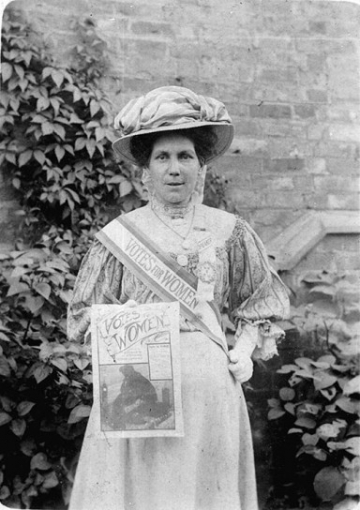Alice Hawkins
The full resource is FREE to all registered users of the website
If you are not already registered you can sign up for FREE website access to download the full resource.

- Born: 1863
- Died: 1947
- Occupation: Factory worker
- Claim to fame: Helped to establish the Leicester branch of the WSPU and was arrested five times
Alice Riley was born into a working- class family in Staffordshire. She left school at13 to work in a shoe factory in Leicester. In 1882, she married Alfred Hawkins. They had seven children.
Poor wages and conditions for women and men in the factories was normal, In 1894, Alice joined the Independent Labour Party (ILP), and the shoe factory where she worked formed its own Women’s Co-operative Guild in 1896, to lobby for good wages and working conditions.
This led Alice to the suffrage movement. She met the Pankhursts through the ILP and supplied Sylvia Pankhurst with data from the shoe factory where she worked, so that Sylvia could write articles on working women’s lives.
In 1907, Alice became the first secretary of the Leicester branch of the Women’s Social and Political Union (WSPU). Also in 1907, she was imprisoned for two weeks for obstructing the police during demonstrations in London. Alice was arrested five times overall, though not all of the arrests are recorded. In 1909, she was put in prison in Leicester for five days for trying to get into a meeting being held there by cabinet minister Winston Churchill, and she went on hunger strike. Alice was sentenced again to two weeks in prison in 1910 when she smashed windows at cabinet minister Lewis Harcourt’s house in reaction to police violence on “Black Friday”. Emmeline Pankhurst paid Alice’s fine so that she could return to her children. In 1911, Alice was again in prison for three weeks for breaking windows at the Home Office, and in 1913, she was sentenced to five days for pouring ink into pillar boxes in Leicester. She went on hunger strike but gave up when friends and family intervened.
Alfred Hawkinswas a member of the Men’s Political Union for Women’s Enfranchisement (MPU), and supported Alice at rallies and while she was in prison. Alfred had his leg broken by stewards after they threw him out of a Liberal Party meeting because he interrupted it to raise the votes for women question. He spent a month in hospital which put the whole family into a financially difficult position. He was later awarded compensation, which set a precedent for the treatment of people at rallies.
Alice spoke personally to Lloyd George at a meeting in 1913 about suffrage and working conditions; despite this, she was one of many women who did not qualify to vote under the terms of the Representation of the People Act in 1918. The Act only granted votes for women aged over 30 and with property qualifications, leaving many working women excluded. Instead, she had to wait another ten years. She remained a social campaigner to the end of her life.
Glossary
- Independent Labour Party – In 1893, the Independent Labour Party was formed to represent the interests of working people and, in 1895, the party conference voted to support suffrage for all men and women.
- Liberal Party – one of the two major political parties in the nineteenth and early twentieth centuries.
- Lloyd George – David Lloyd George was leader of the Liberal Party and Prime Minister from 1916-22.
Questions
- What drove working-class women with little education to campaign for women’s rights?
- Did it matter that Alice’s family supported her at suffrage events?
- How do you think it must have felt for Alice to still be disenfranchised after the 1918 Act?
